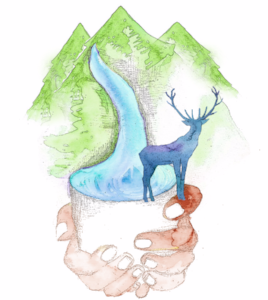Heard “the Howl” of Howler Monkeys
Around 6:00 am; one deep, cacophonous cry starts, followed by another, until the whole troop of wild Mantled Howler monkeys (Alouatta palliata) sound in sync with “the howl”. Every morning, to my gratitude, I was woken to a number of Mantled Howler monkeys letting loose their lungs in concert. These vocal primates can be heard up to three kilometers away as they send a clear message to other monkeys that this territory is theirs.
At the Mantled Howler monkey rehabilitation/ research center on Batipa Peninsula, Panama, my morning continued with caring for three infant howler monkeys. Around ages three to four months these infants have playful personalities with their only days’ work to “monkey around” in the tree tops. Atlas, the stronger and biggest baby out of the three, likes to nibble at the ankles and jump on any monkey that stands in her way. Chito (I like to spell her name as Cheeto) on the other hand, entices Atlas to rough play and then retreats very quickly back into the branches if she feels too threatened. Cheeto is also the smallest monkey that loves to climb down anyone’s shirt given the chance. Then there is Penny, sweet and independent Penny. Penny is distinct with her grey beard and big smile, and enjoys playing with the other two, but she is so sweet that her version of rough play is more of a long cuddle. At times, all the infants became affectionate as they purr in each other’s ears and lick each other’s faces. These three females are forming a social bond, acquiring naturalistic foraging knowledge, learning vocalization cues from wild howlers and becoming familiar with traveling on forest substrates. Our efforts were to rehabilitate the monkeys so they can be released back into the wild in possibly two to three years.
Primates, like Atlas, Cheeto and Penny, were brought to the sanctuary by the Ministry of Environment in Panama after being seized from the illegal pet trade or who were orphaned due to the expansion of human development and hunting of their mothers. Although Mantled Howler monkeys are still classified as “Least Concern” by the IUCN, four out of five Mantled Howler monkey subspecies are threatened with extinction. The species populations continue to decline due to anthropogenic threats (i.e. bushmeat, deforestation and the pet trade) and given these threats, the number of animals injured or confiscated by wildlife agencies is increasing. The International Species Information Services (ISIS) indicated that there is no Mantled Howler monkeys kept in captivity in any of the 911 zoos and aquaria across 85 countries present in their database (ISIS, 2015; Pastor-Nieto, 2015). Thus, rehabilitation and release become essential to give these primates a fighting chance.
My work played a small part in the lives of these monkeys, but by continuing successful rehabilitation the hope is that Atlas, Cheeto and Penny will have fulfilling monkey lives in the wild. These unique animals play an important role in the ecosystem of the rainforest and they should continue to be protected.
Fact: To some Mayan tribes of the Classic Period, the howler monkeys were seen as divine Gods, and the long, sleek tail was worshipped for its beauty.
Fact: Howler monkeys tails have tactile pads, meaning they can feel with the same aptitude as their hands and feet acting almost as a “fifth limb”.
Infant Mantled Howler Monkey: Chito (or as I like to name her, Cheeto)
Infant Mantled Howler Monkey: Atlas


